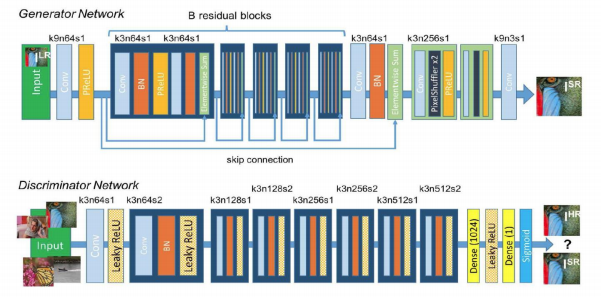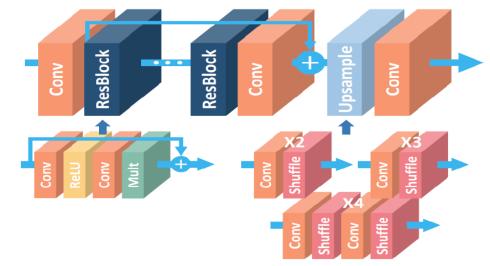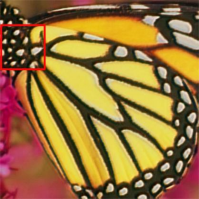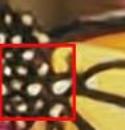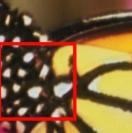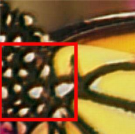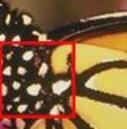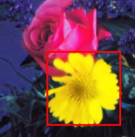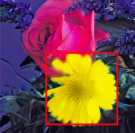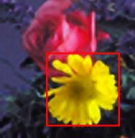1. Introduction
Images are now ubiquitous on every platform on the Internet. Compared with low-resolution images, high-resolution images usually have a better user viewing experience, the higher the resolution of the image, the more comfortable it will be for users to get valuable information in the image. Therefore, in general, web users want the image resolution to be as high as possible, and the network platform that can support higher resolution images will become more competitive in the market, due to that, the method that can provide more high-resolution images to network users at low cost has a very high application value.
However, actually, due to the constraints of imaging equipment, resolution ofacquisition equipment, various physical factors during image acquisition and transmission, image degradation and other factors[1], Directly produce ideal high-resolution images with low cost and high efficiency is usually too difficult to realize. And image super-resolution reconstruction technology can help overcome the difficulty. Image super-resolution reconstruction refers to transform a low-resolution image into a higher-resolution image through an algorithm trained in advance[1]. Using the image super-resolution reconstruction algorithm, Problems such as low quality and serious noise pollution caused by various unfavorable conditions of image acquisition, image blur or transportation can be avoided[2]. If we successfully develop an image super-resolution algorithm suits requirement, we just need to transfer
low-resolution images, and transform them through the well-prepared image super-resolution reconstruction algorithm, then we can get the high-resolution images we need. In this way, we successfully circumvent constraints indirect transmission of high-resolution images, and can better meet the needs of users with the existing limited resources and conditions.
This paper first introduces the development history of image super-resolution reconstruction algorithm, then introduces SRGAN algorithm based on SRCNN algorithm, and introduces its structure and main defects in detail, as well as the basic role of Batch Norm operation in SRGAN algorithm, its negative impact on SRGAN algorithm, and the specific principle of reducing the performance of the algorithm. To solve this problem, we explore the influence of using EDSR algorithm, which Batch Norm operation is deleted, as the alternative of SRResNet to be the generator on the performance of SRGAN algorithm. Through experimental verification and testing with multiple datasets, we find that the performance of the algorithm is significantly improved.
2. Super resolution algorithm using deep learning
In 2006, Hintonetal.[3] first proposed deep learning. Deep learning can extract various abstract features of data and use these features to find rules, so as to enhance the performance of the algorithm. The most critical step on image super-resolution reconstruction is how we can make computer restore the information lost when the image resolution decreases as accurately as possible. Deep learning can be used to make the computer learn how to do this independently, which suits this very much, so that the trained computer can produce output images which are very close to the initial image. It makes deep learning extremely fit the need for the further development of image super-resolution reconstruction, also makes more and more researchers begin to try to explore the utilization of deep learning to create a new image super-resolution reconstruction algorithm with more superior performance[4], especially the convolution neural network, serves as an indispensable tool in the further development of the image resolution reconstruction[5].
In 2014, Dong C, et al.[6], as the pioneers, successfully utilized deep learning into image super- resolution reconstruction firstly[7], and their model is named as the SRCNN model, and successfully achieved a superior performance than most of the traditional methods, although the main principle of SRCNN is relatively simple. Since then, deep learning has set off a wave in super-resolution reconstruction. The algorithm firstly expand the low-resolution images to the expected resolution using bicubic interpolation to , and then transform them. Finally the output image with higher resolution is produced by a three-layer convolution neural network.
Reconstruct
Figure 1. Structure of SRCNN.
Although the rational application of deep learning technology makes SRCNN algorithm outperform many traditional image processing algorithms at that time in performance, it also has an inevitable defect,
that is, it adopts MSE loss function as the final objective function. Misled by the MSE function, despite that the reconstructed image performs well on PSNR and SSIM, in fact, the reconstructed image does not well conform to the subjective feelings of human eyes. The author of the later SRGAN algorithm pointed out that this is because the objective function only pays attention to the differences between image pixels and ignores the overall structure of the image. Using this loss function to reconstruct the image will make the reconstructed image lose a lot of details and texture information, resulting in the actual image quality not as good as expected[7].
The calculation formula of MSE loss function is as follows:
MSEloss(xi, yi) = (xi − yi)2 (1)
With the purpose of avoiding the inherent defects of MSE loss function adopted by SRCNN, SRGAN algorithm uses the Generative Adversarial Networks(GAN) to create the extra information after the image resolution is improved, and defines a new perception objective function to calculate the loss.
In that paper[7], the author also proposed a comparison algorithm named SRResNet. Although it still choose theMSEas its loss function, SRResNet uses a deep enough residual convolution network model, Which makes it different from the past algorithm and can also achieve better reconstructed images in contrast with other image super-resolution reconstruction algorithms using MSE function.
3. Introduction of SRGAN
3.1. Generative adversarial network
The following image depicts the basic principle of GAN network:
Figure 2. The principle of GAN.
Compared with SRCNN algorithm, the biggest difference of SRGAN algorithm is that it adopts generative adversarial network to fit the extra information after the image resolution is improved.
GAN[8] is mainly enlightened by the ideology of the game theory. GAN constructs two deep learning models named generator and discriminator. Firstly, generator network produces images through a specific convolution neural network; Then discriminator network determines whether the image is the original one or is reconstructed by generator network. The task of generator network is to produce realistic images as realistic as it can to confuse discriminator network and make it fail to judge; Similarly, discriminator network holds the task to check if the image is fake image generated by generator network.
3.2. The Loss function of SRGAN
SRGAN proposed a new loss function with more superior performance.It is the sum of two loss functions: content loss and adversarial loss.
The calculation formula of SRGAN's loss function is shown as below:
Ln = ∑=1 −logDθD (GθG (ILR ))
(3)
LSR = LR + 10−3Ln
(4)
Formula (2) Formula (3) and Formula (4) refer to the content loss, adversarial loss and the loss of SRGAN, respectively.
SRGAN defines content loss as the feature map of high-frequency features of VGG-54, while adversarial loss is the deficiency generated from adversarial process of GAN network, which mainly focuses on texture details[7].
4. Improvement of SRGAN algorithm
In the SRGAN algorithm, the SRResNet algorithm is adopted by the generator of GAN network achieved better results than other traditional image superscore algorithms at that time. However, the ResNet network structure was initially designed oriented to the high-level computer vision problem, while the image superresolution belongs to the low-level computer vision problem. It is likely not the best choice to apply the structure of ResNet network to image super-resolution reconstruction[9] without any modifications. In detailed the key problem of doing so is that the Batch normalization operation(BN) does not perform well in image super-resolution reconstruction.
BN[10] is an important technology in deep learning, which cannot only simplify the process to train deeper networks and reduce the time of model convergence, but also prevent model become overfitting during training. However, BN does not perform well in terms of image super-resolution and image generation[11] Roughly speaking, BN is similar to a contrast stretch for an image. After the image is operated by BN, the image’s color distribution will be normalized, which will destroy the original contrast information of the image. Therefore, BN will make the model training speed unstable, and even the loss function diverges at last. When BN is added to the neural network used in image super- resolution[12], the images output produced by the network are required not to do any modification with the color, contrast and brightness of input images, but only the resolution and some details are changed. Therefore, the existence of BN impairs the quality of the reconstructed images of convolutional neural network.
This paper proposes an improved generator model of SRGAN, which replaces the original SRResNet algorithm with its modified version: EDSR algorithm[13]. Compared with SRResNet, the most meaningful modification of EDSR[14] is to remove the superfluous module BN, so that the resources previously taken by BN can be used to other valuable parts[14]. After deleting the BN, EDSR can utilize the resources to deepen the convolution neural network layers and can extract more features of input images with the same computing resources, so that EDSR will have better performance than SRResNet. In the training period, EDSR trains the low-fold upsampling model first, so as to obtain the parameters extracted from the training of that model, which can be used to initialize and can accelerate the training period of the high-fold upsampling model, which usually will be time-consuming, and also after training the model will be competent to produce images with higher quality.
The following is the network structure diagram of EDSR algorithm:
Figure 3. The structure of EDSR.
5. Result and analysis of experiment
5.1. Environment of experiment
The operating system of this experiment is Windows10, and the programming language is Python. The software PyCharm is used as the platform, and PyTorch deep learning framework is selected as the development model, which is implemented by Python 3.7 compilation.
The evaluation indexes adopted in this experiment are SSIM[5], PSNR and MOS. The closer the SSIM value is to 1, the more extraordinary the feature retention degree of the reconstructed HD output image is. The higher the PSNR value, the less the proportion of noise generated by HD output image reconstruction[9]. However, as mentioned above, we cannot judge the effect of image reconstruction only by SSIM and PSNR, so we introduce MOS as a complement. MOS is to ask the raters to rate the images from a minimum of 1 (low visual quality) to a maximum of 5 (high visual quality). Therefore, MOS depends on human eyes to judge the effect of image reconstruction. Generally speaking, MOS is more capable of reflecting photo-realistic images than SSIM and PSNR[15].
5.2. Introduction of dataset
For the training data, Urban100 is selected as the data set in this paper. First, 100 original high-resolution images in the data set are downsampled, after that the obtained low-resolution images are selected and preserved as the original data for the training of the model.
For the test data, Set5, Set14 and DIV2K datasets were selected as samples to judge the performance of each network models in this experiment.
5.3. Result of experiment
5.3.1. Experimental data of SRCNN, SRGAN and Ours. The Comparison of SRCNN, SRGAN and ours is shown in the following table:
Dataset Evaluation index HR SRCNN SRGAN Ours
|
|
|
|
|
||
|
|
|
|
|
|
|
|
|
|
|
|
||
|
|
|
|
|
||
|
|
|
|
|
|
|
|
|
|
|
|
||
|
|
|
|
|
||
|
|
|
|
|
|
|
|
|
|
|
|
||
According to the table data, as mentioned above, under the influence of MSE loss function, SRResNet[7] has the highest PSNRand SSIM, but lower MOS, while SRGAN utilizes generative adversarial network. And loss function with better performance to improve the realism of reconstructed images. Although SSIM and PSNR are not as good as SRResNet, MOS is significantly better than SRResNet, indicating that SRGAN performs better than SRRestNet.
The image super-resolution reconstruction algorithm based on EDSR and improved SRGAN proposed in this paper performs similar to SRGAN with good visual sensory effects in terms of evaluation indexes. While keeping the subjective evaluation index MOS high, the objective evaluation indexes PSNR and SSIM values are improved, which proves that the proposed algorithm has better comprehensive performance.
5.3.2. Comparison of visual effects
HR SRCNN SRGAN Ours
Figure 4. Original high resolution image compared with reconstruct result of img_003 of set5 using SRCNN, SRGAN, and Our algorithm.
HR SRCNN SRGAN Ours
Figure 5. Original High resolution image compared with reconstruct result of img_007 of set14 using SRCNN, SRGAN, and Our algorithm.
It can be easily found that on the above figures, Compared with our image super-resolution reconstruction algorithm based on EDSR and improved SRGAN, the original SRGAN has more serious ringing phenomenon.
Ringing effect[15] is one of the common factors influencing the recovery image quality, its[16] impact on the quality of restored image is serious, is must avoid factors in the process of image restoration, but in fact ringing effect in the process of recovery is almost inevitable, especially when the noise appears in the image, it will destroy the frequency characteristic of image, so that ringing effect is more significant, Exacerbating the degradation of image quality.
Batch Norm operation performs similarly to the noise, it will diverge the training model and normalize the color distribution on image, which destroys the original contrast information on image. In image super-resolution reconstruction , it makes ringing phenomenon in the image more serious and affects the reconstruction effect of the image. In this paper, ENSR algorithm is applied to the improvement of SRGAN algorithm, and this problem is better solved, so that the quality of reconstructed images is significantly improved.
6. Summary
In this paper, we propose our algorithm based on EDSR and improved SRGAN. The main change is that the generator is modified by referring to the EDSR algorithm. The main change is that the BN
operation in the SRGAN generation network is deleted. The improved algorithm can significantly improve the quality and running speed of reconstructed images. The result from experiment indicates that the reconstructed image of the modified algorithm is superior to the traditional SRGAN on PSNR, SSIM and MOS.
References
[1]. Sun, H. J. and Wu, J. J. (2005) Urban traffic congestion spreading in small world networks. International Journal of Modern Physics B: Condensed Matter Physics; Statistical Physics; Applied Physics, Vol. 19 Issue 28, pp. 4239-4246. 8p. 7 Graphs.
[2]. Wu, J. J., Gao, Z. Y., Sun, H. J. (2004) Simulation of traffic congestion with SIR model. Modern Physics Letters B, Vol. 18 Issue 30, pp. 1537-1542. 6p.
[3]. Meead, S., Mudabber, A., Homayoun, H., Amir, H. S., Gu, Z. Y., Sajjad, S., Divya J, C., Vinayak, D., Lauren, G., Travis, W. S., Marta C, G. (2019) A simple contagion process describes spreading of traffic jams in urban networks. [online]Available at <http://login.ez.xjtlu.edu.cn/login?url=https://search.ebscohost.com/login.aspx?direct=true&db=edsarx&AN=edsarx.1906.00585&site=eds-live&scope=site > (04/04/2022 16:53)
[4]. Getachew K, B. (2021) 2021 55th Annual Conference on Information Sciences and Systems (CISS) Information Sciences and Systems (CISS). In: Baltimore, MD, USA. pp. 1-3.
[5]. Teja, I., Kaan, O., Sandeep, M. (2012) Analytical modeling of vehicle-to-vehicle communication using spread of infection models. 2012 IEEE International Conference on Vehicular Electronics and Safety (ICVES 2012) Vehicular Electronics and Safety (ICVES). In: Istanbul, Turkey. pp. 217-222.
[6]. Zeng, Z. L. and Li, T. X. (2018) Analyzing Congestion Propagation on Urban Rail Transit Oversaturated Conditions: A Framework Based on SIR Epidemic Model. Urban Rail Transit, 4(3):130-140
[7]. Shi, Z., Zhang, N., Zhu, l. (2019) Understanding the Propagation and Control Strategies of Congestion in Urban Rail Transit Based on Epidemiological Dynamics Model. Information (Switzerland), Vol. 10 Issue 8, pp. 258-258, 1p.
[8]. Gurin, D., Prokhorchenko, A., Kravchenko, M., Shapoval, G. (2020) Development of a method for modelling delay propagation in railway networks using epidemiological SIR models. Eastern-European Journal of Enterprise Technologies, Vol. 108 Issue 3, pp. 6-13, 8p.
[9]. Zhao, Y. and Ding, X. B. (2021) The Research on Delay Propagation of Urban Rail Transit Operation under Sudden Failure. Journal of Advanced Transportation, pp. 1-10. 10p.
[10]. Watmough, J. and van den Driessche, P. (2002). Reproduction numbers and sub-threshold endemic equilibria for compartmental models of disease transmission. Mathematical Biosciences, 180, pp. 29-48.
Cite this article
Chen,K. (2023). Research on traffic congestion situation in urban central area based on SIR model. Applied and Computational Engineering,2,422-430.
Data availability
The datasets used and/or analyzed during the current study will be available from the authors upon reasonable request.
Disclaimer/Publisher's Note
The statements, opinions and data contained in all publications are solely those of the individual author(s) and contributor(s) and not of EWA Publishing and/or the editor(s). EWA Publishing and/or the editor(s) disclaim responsibility for any injury to people or property resulting from any ideas, methods, instructions or products referred to in the content.
About volume
Volume title: Proceedings of the 4th International Conference on Computing and Data Science (CONF-CDS 2022)
© 2024 by the author(s). Licensee EWA Publishing, Oxford, UK. This article is an open access article distributed under the terms and
conditions of the Creative Commons Attribution (CC BY) license. Authors who
publish this series agree to the following terms:
1. Authors retain copyright and grant the series right of first publication with the work simultaneously licensed under a Creative Commons
Attribution License that allows others to share the work with an acknowledgment of the work's authorship and initial publication in this
series.
2. Authors are able to enter into separate, additional contractual arrangements for the non-exclusive distribution of the series's published
version of the work (e.g., post it to an institutional repository or publish it in a book), with an acknowledgment of its initial
publication in this series.
3. Authors are permitted and encouraged to post their work online (e.g., in institutional repositories or on their website) prior to and
during the submission process, as it can lead to productive exchanges, as well as earlier and greater citation of published work (See
Open access policy for details).
References
[1]. Sun, H. J. and Wu, J. J. (2005) Urban traffic congestion spreading in small world networks. International Journal of Modern Physics B: Condensed Matter Physics; Statistical Physics; Applied Physics, Vol. 19 Issue 28, pp. 4239-4246. 8p. 7 Graphs.
[2]. Wu, J. J., Gao, Z. Y., Sun, H. J. (2004) Simulation of traffic congestion with SIR model. Modern Physics Letters B, Vol. 18 Issue 30, pp. 1537-1542. 6p.
[3]. Meead, S., Mudabber, A., Homayoun, H., Amir, H. S., Gu, Z. Y., Sajjad, S., Divya J, C., Vinayak, D., Lauren, G., Travis, W. S., Marta C, G. (2019) A simple contagion process describes spreading of traffic jams in urban networks. [online]Available at <http://login.ez.xjtlu.edu.cn/login?url=https://search.ebscohost.com/login.aspx?direct=true&db=edsarx&AN=edsarx.1906.00585&site=eds-live&scope=site > (04/04/2022 16:53)
[4]. Getachew K, B. (2021) 2021 55th Annual Conference on Information Sciences and Systems (CISS) Information Sciences and Systems (CISS). In: Baltimore, MD, USA. pp. 1-3.
[5]. Teja, I., Kaan, O., Sandeep, M. (2012) Analytical modeling of vehicle-to-vehicle communication using spread of infection models. 2012 IEEE International Conference on Vehicular Electronics and Safety (ICVES 2012) Vehicular Electronics and Safety (ICVES). In: Istanbul, Turkey. pp. 217-222.
[6]. Zeng, Z. L. and Li, T. X. (2018) Analyzing Congestion Propagation on Urban Rail Transit Oversaturated Conditions: A Framework Based on SIR Epidemic Model. Urban Rail Transit, 4(3):130-140
[7]. Shi, Z., Zhang, N., Zhu, l. (2019) Understanding the Propagation and Control Strategies of Congestion in Urban Rail Transit Based on Epidemiological Dynamics Model. Information (Switzerland), Vol. 10 Issue 8, pp. 258-258, 1p.
[8]. Gurin, D., Prokhorchenko, A., Kravchenko, M., Shapoval, G. (2020) Development of a method for modelling delay propagation in railway networks using epidemiological SIR models. Eastern-European Journal of Enterprise Technologies, Vol. 108 Issue 3, pp. 6-13, 8p.
[9]. Zhao, Y. and Ding, X. B. (2021) The Research on Delay Propagation of Urban Rail Transit Operation under Sudden Failure. Journal of Advanced Transportation, pp. 1-10. 10p.
[10]. Watmough, J. and van den Driessche, P. (2002). Reproduction numbers and sub-threshold endemic equilibria for compartmental models of disease transmission. Mathematical Biosciences, 180, pp. 29-48.














